
https://ift.tt/3on1SWk
Science


At least five fireball sightings were reported in the U.S. on Friday evening, according to NASA.
NASA Meteor Watch wrote in a Facebook post on Saturday that there were “many reports” related to the sightings. But the largest number of eyewitness accounts — more than 80 — stemmed from an event that occurred around 7:40 p.m. ET on the North Carolina coast.
“An analysis of these accounts shows that the meteor skimmed the coast of North Carolina, becoming visible 48 miles above the ocean off Camp Lejeune, moving northeast at 32,000 miles per hour,” the post read.
America is changing faster than ever! Add Changing America to your Facebook or Twitter feed to stay on top of the news.
The meteor eventually “disintegrated” after traveling 26 miles through Earth’s upper atmosphere.
“There is more than the usual amount of uncertainty in the trajectory solution due to all the observers being located to the west of the fireball,” the post continued.
NASA Meteor Watch linked a video from one of the sightings.
The American Meteor Society received 171 reports of a fireball viewed the same evening over Maryland, North Carolina, South Carolina, Virginia and West Virginia.
READ MORE STORIES FROM CHANGING AMERICA
AMERICAN AIRLINES PASSENGER CLIMBS ONTO WING OF PLANE AS IT TAXIS ON RUNWAY
VACCINATED COUPLE DIE OF COVID-19 HOLDING HANDS
MICE VICARIOUSLY EXPERIENCING DEFEAT GET DEPRESSED
TEEN TRUCK DRIVER HITS 6 BICYCLISTS IN ATTEMPT TO BLOW EXHAUST ON THEM
CHEROKEE NATION MEMBERSHIP SURGES TO 400,000 STRONG
Article From & Read More ( NASA reports multiple fireballs hurtling through the sky over US | TheHill - The Hill )[unable to retrieve full-text content]
(CNN)While the Isle of Wight may be better suited for tourists these days, it was once "Dinosaur Island."


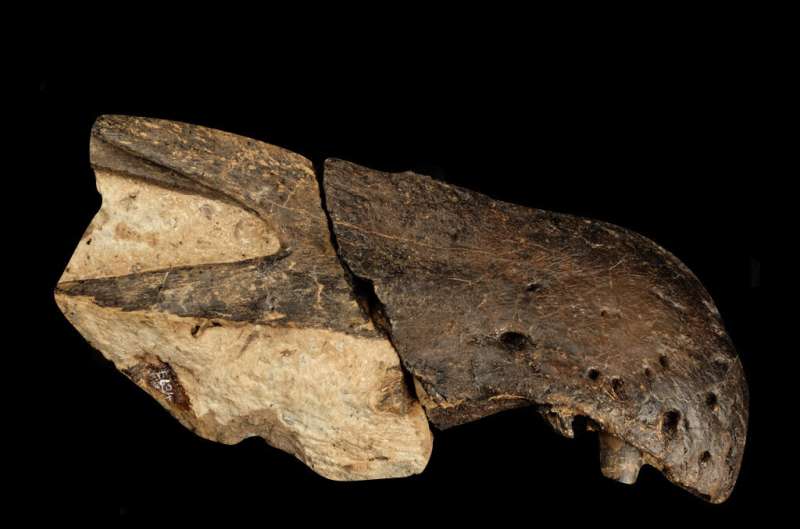
A new study led by palaeontologists at the University of Southampton suggests that bones found on the Isle of Wight belong to two new species of spinosaurid, a group of predatory theropod dinosaurs closely related to the giant Spinosaurus. Their unusual, crocodile-like skulls helped the group expand their diets, allowing them hunt prey on both land and in the water.
The haul of bones was discovered on the beach near Brighstone over a period of several years. Keen-eyed fossil collectors initially found parts of two skulls, and a crew from Dinosaur Isle Museum recovered a large portion of a tail. In all, over 50 bones from the site have been uncovered from rocks that form part of the Wessex Formation, laid down over 125 million years ago during the Early Cretaceous.
The only spinosaurid skeleton previously unearthed in the UK belonged to Baryonyx, which was initially discovered in 1983 in a quarry in Surrey. Most other finds since have been restricted to isolated teeth and single bones.
Analysis of the bones carried out at the University of Southampton and published in Scientific Reports suggested they belonged to species of dinosaurs previously unknown to science.
Chris Barker, a Ph.D. student at the University of Southampton and lead author of the study, said: "We found the skulls to differ not only from Baryonyx, but also one another, suggesting the UK housed a greater diversity of spinosaurids than previously thought."
The discovery of spinosaurid dinosaurs on the Isle of Wight was a long time coming. "We've known for a couple of decades now that Baryonyx-like dinosaurs awaited discovered on the Isle of Wight, but finding the remains of two such animals in close succession was a huge surprise" remarked co-author Darren Naish, expert in British theropod dinosaurs.
The first specimen has been named Ceratosuchops inferodios, which translates as the "horned crocodile-faced hell heron". With a series of low horns and bumps ornamenting the brow region the name also refers to the predator's likely hunting style, which would be similar to that of a (terrifying) heron. Herons famously catch aquatic prey around the margins of waterways but their diet is far more flexible than is generally appreciated, and can include terrestrial prey too.
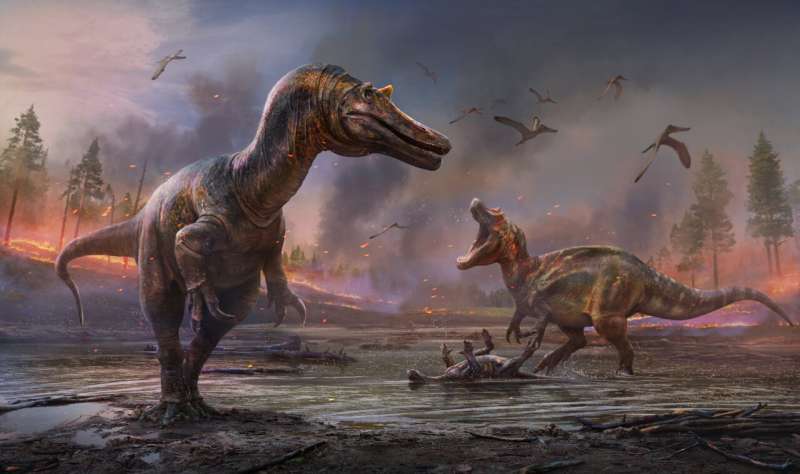
The second was named Riparovenator milnerae. This translates as "Milner's riverbank hunter", in honour of esteemed British palaeontologist Angela Milner, who recently passed away. Dr. Milner had previously studied and named Baryonyx—a major palaeontological event whose discovery substantially improved our understanding of these distinctive predators.
Dr. David Hone, co-author from Queen Mary University of London: "It might sound odd to have two similar and closely related carnivores in an ecosystem, but this is actually very common for both dinosaurs and numerous living ecosystems."
Although the skeletons are incomplete, the researchers estimate that both Ceratosuchops and Riparovenator measured around nine metres in length, snapping up prey with their metre-long skulls. The study also suggested how spinosaurids might have first evolved in Europe, before dispersing into Asia, Africa and South America.
Dr. Neil J. Gostling of the University of Southampton, who supervised the project, said: "This work has brought together universities, Dinosaur Isle museum and the public to reveal these amazing dinosaurs and the incredibly diverse ecology of the south coast of England 125 million years ago."
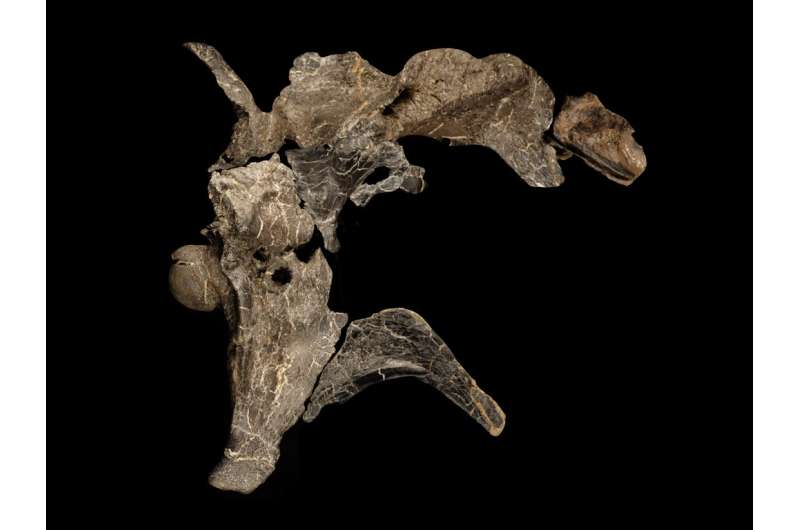
The Early Cretaceous rocks on the Isle of Wight describe an ancient floodplain environment bathed in a Mediterranean-like climate. Whilst generally balmy, forest fires occasionally ravaged the landscape, and the remains of burnt wood can be seen throughout the cliffs today. With a large river and other bodies of water attracting dinosaurs and housing various fish, sharks and crocodiles, the habitat provided the newly discovered spinosaurids with plenty of hunting opportunities.
Fossil collector Brian Foster from Yorkshire, who made an important contribution to the finds and publication, said: "This is the rarest and most exciting find I've made in over 30 years of fossil collecting". Fellow collector Jeremy Lockwood, who lives on the Isle of Wight and discovered several bones added, "we realised after the two snouts were found that this would be something rare and unusual. Then it just got more and more amazing as several collectors found and donated other parts of this enormous jigsaw to the museum."
Dr. Martin Munt, Curator of Dinosaur Isle Museum, noted how these new finds cement the Isle of Wight's status as one of the top locations for dinosaur remains in Europe. The project also solidified how collectors, museums and universities can work together to bring fossil specimens to light.
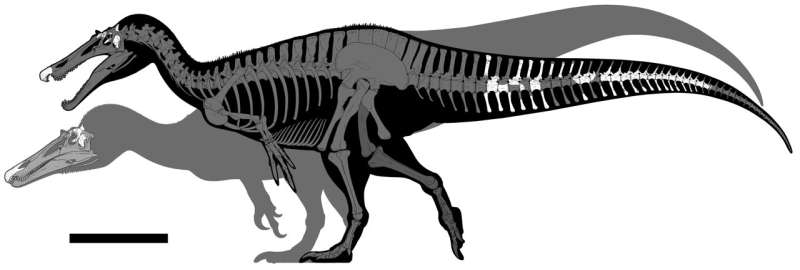
Dr. Munt added: "On behalf of the museum I wish to express our gratitude to the collectors, including colleagues at the museum, who have made these amazing finds, and made them available for scientific research. We also congratulate the team who have worked on these exciting finds and brought them to publication."
The new fossils will go on display at Dinosaur Isle Museum at Sandown.
Explore further
Citation: Two new species of large predatory dinosaur discovered on Isle of Wight (2021, September 29) retrieved 29 September 2021 from https://ift.tt/3zVSmvn
This document is subject to copyright. Apart from any fair dealing for the purpose of private study or research, no part may be reproduced without the written permission. The content is provided for information purposes only.
Carlene Knight, who has a congenital eye disorder, volunteered to let doctors edit the genes in her retina using CRISPR. Franny White/OHSU
Carlene Knight's vision was so bad that she couldn't even maneuver around the call center where she works using her cane.
"I was bumping into the cubicles and really scaring people that were sitting at them," says Knight, who was born with a rare genetic eye disease.
But that's changed, as a result of volunteering for a landmark medical experiment. Her vision has improved enough for her to make out doorways, navigate hallways, spot objects and even see colors.
"It's nice. I don't scare people and I don't have as many bruises on my body," Knight says, laughing.
Knight is one of seven patients with a rare eye disease who volunteered to let doctors modify their DNA by injecting the revolutionary gene-editing tool CRISPR directly into cells that are still in their bodies. Knight and one other study volunteer gave NPR exclusive interviews about their experience.
This is the first time researchers worked with CRISPR this way. Earlier experiments had removed cells from patients' bodies, edited them in the lab and then infused the modified cells back into the patients.
On Wednesday, researchers revealed the first evidence that the approach appears to be working — improving vision for at least some patients with the condition, known as Leber congenital amaurosis, or LCA, a severe form of vision impairment.
"It's a really amazing technology and very powerful," says Dr. Mark Pennesi, professor of ophthalmology at the Casey Eye Institute at the Oregon Health & Science University. He presented the results at an International Symposium on Retinal Degeneration in Nashville, Tenn.
Pennesi cautioned that more patients need to be treated and followed longer to confirm the approach is safe and to determine just how much it can help patients. But the current results are so promising that the researchers have gotten the go-ahead to move on to the next group of patients.
Knight's vision is much clearer and brighter since getting the experimental treatment. Instead of having to reach around blindly to find objects, she can simply look for them.
Recently, for example, when she dropped a fork on her kitchen floor, she says, "I just leaned down to pick it up and didn't know where it was and just saw it on the floor. It's very cool."
Colors are also much brighter and more vivid.
"I've always loved colors. Since I was a kid it's one of those things I could enjoy with just a small amount of vision. But now I realize how much brighter they were as a kid because I can see them a lot more brilliantly now," she says. "It's just amazing."
So Knight, who's 55 and lives outside Portland, Oregon, dyed her hair her favorite color, green, to celebrate.
"It's kind of fun to see," she says, laughing.
LCA is caused by a genetic mutation that disables crucial cells in the retina. Patients experience a progressive loss of vision starting at birth that usually renders them legally blind. The treatment is far from curing the patients in the trial, but the changes some experienced are significant enough to have a meaningful impact on their daily lives.
Michael Kalberer Mass Eye and Ear
Another volunteer in the experiment, Michael Kalberer, can also now see colors for the first time in years. He noticed it about a month after the procedure when a red car drove past. But the most dramatic moment occurred on the dance floor of his cousin's wedding.
"I could see the DJ's strobe lights change color and identify them to my cousins who were dancing with me," says Kalberer. "That was that was a very, very fun joyous moment."
Kalberer, who's 43 and lives on Long Island, can also recognize shapes and light much better and he regained more peripheral vision, which makes it way easier to do simple things like eat in a restaurant.
"It has enabled me to navigate a plate of food and stab food a little bit easier. If I look down at a plate of food and there's spoon or utensil in it I can see the edge of the utensil on the outside of the bowl or plate," Kalberer says. "So those changes are very, very significant to me."
He can even finally watch sunsets again. He recalls the first time he saw one after the treatment. He was coming home from a meal with a friend when he saw pink in the sky.
"She goes, 'Yeah, you see the sunset. That's the sunset.' And we both smiled at each other," Kalberer says. "It was a great moment."
Kalberer saw colored lights on the dancefloor at his cousin's wedding. "That was that was a very, very fun joyous moment," he says.

Source: Michael Kalberer
CRISPR is already showing promise for treating devastating blood disorders like sickle disease disease and beta thalassemia. And doctors are trying to use it to treat cancer. But those experiments involve taking cells out of the body, editing them in the lab, and then infusing them back into patients. That's impossible for diseases like LCA, because cells from the retina can't be removed and then put back into the eye.
So doctors genetically modified a harmless virus to ferry the CRISPR gene-editor and infused billions of the modified viruses into the retinas of Knight's left eye and Kalberer's right eye, as well as one eye of five other patients. The procedure was done only on only one eye just in case something went wrong. The doctors hope to treat the patients' other eye after the research is complete.
Once the CRISPR was inside the cells of the retinas, the hope was that it would cut out the genetic mutation causing the disease, restoring vision by reactivating the dormant cells.
"We're thrilled about this," says Dr. Eric Pierce, director of the ocular genomics institute at Massachusetts Eye & Ear and professor of ophthalmology at Harvard Medical School who's helping run the experiment testing the approach.
"We're thrilled to see early signs of efficacy because that means gene-editing is working. This is the first time we're having evidence that gene-editing is functioning inside somebody and it's improving — in this case — their visual function," Pierce says.
The procedure didn't work for all the patients, who have been followed for between three and nine months. The reasons it didn't work might have been because their dose was too low or perhaps because their vision was too damaged.
Michael Kalberer during a check-up at Massachusetts Eye and Ear. Mass Eye and Ear
But Kalberer, who got the lowest dose, and one volunteer who got a higher dose, began reporting improvement starting at about four to six weeks after the procedure. Knight and one other patient who received a higher dose improved enough to show improvement on a battery of tests that included navigating a maze. For two others, it's too soon to tell.
None of the patients have regained normal vision — far from it. But the improvements are already making a difference to patients, the researchers say. And no significant side effects have occurred.
Many more patients will have to be treated and followed for much longer, to make sure the treatment is safe and know just how much this might be helping.
The researchers have begun administering a higher dose, which could work better, and eventually plan to start treating children, who have the best chance of benefiting.
They're also optimistic the vision of the patients treated so far could improve with time.
"When you improve the function of the retina, sometimes there's a lag for the brain being able to recognize and use that vision," Pennesi says. "It takes time to learn how to use that improved vision."
The findings could open the door to using the same approach to treat other diseases where doctors can't take cells out of the body, including brain disorders like Huntington's and muscle diseases like muscular dystrophy.
"It's exciting. The world is our oyster. We almost have too many targets that we can go after," says Dr. Lisa Michaels, chief medical officer at Editas Medicine, which is sponsoring the study.
For their part, Knight and Kalberer are just thrilled that they can see at least a little better.
"I'm just incredibly honored and privileged to be part of this, and very, very excited to literally, hopefully, see what comes in the future," Kalberer says.
Article From & Read More ( CRISPR Gene-Editing Experiment Partly Restores Vision In Legally Blind Patients : Shots - Health News - NPR )
A cave chamber sealed off by sand for some 40,000 years has been discovered in Vanguard Cave in Gibraltar — a finding that could reveal more about the Neanderthals who lived in the area around that time.
"Given that the sand sealing the chamber was [40,000] years old, and that the chamber was therefore older, it must have been Neanderthals," who lived in Eurasia from about 200,000 to 40,000 years ago and were likely using the cave, Clive Finlayson, director of the Gibraltar National Museum, told Live Science in an email.
Related: Photos: See the ancient faces of Neanderthals
While Finlayson's team was studying the cave last month, they discovered the hollow area. After climbing through it, they found it is 43 feet (13 meters) in length, with stalactites hanging like eerie icicles from the chamber ceiling. Along the surface of the cave chamber, the researchers found the remains of lynx, hyenas and griffon vultures, as well as a large whelk, a type of sea snail that was likely carried into the chamber by a Neanderthal, the archaeologists said in a statement.
The researchers are eager to see what they will find once they start excavating. One possibility is that the team will discover Neanderthal burials, Finlayson said. "We found the milk tooth of a 4-year-old Neanderthal close to the chamber four years ago," he said. The tooth "was associated with hyenas, and we suspect the hyenas brought the child [who was likely dead] into the cave."
Researchers have discovered plenty of evidence of Neanderthals' presence in the cave system, called the Gorham's Cave Complex, including a carving that may have been early Neanderthal artwork. In addition, findings have suggested that, at this cave system, our closest extinct relatives butchered seals, plucked feathers off birds of prey to wear as ornaments and used tools, Live Science previously reported. Scientists have speculated that this cave system may have been one of the last places Neanderthals lived before they went extinct around 40,000 years ago.
Originally published on Live Science.
[unable to retrieve full-text content]
NASA's Lucy asteroid probe is set to begin its 12-year space odyssey next month.
Lucy is scheduled to launch atop a United Launch Alliance Atlas V rocket from Florida's Cape Canaveral Space Force Station on Oct. 16. The liftoff will kick off a landmark mission that will see Lucy get up close and personal with eight different space rocks over the next dozen years.
"We're visiting more asteroids than any other spacecraft in history," Lucy principal investigator Hal Levison, of the Southwest Research Institute (SwRI) in Boulder, Colorado, said during a news conference on Tuesday (Sept. 28).
"We're also going to exceed another [record]: We're going farther from the sun than any other solar-powered spacecraft in history," Levison added.
Lucy will take the distance crown from NASA's Juno probe, which has been orbiting Jupiter since July 2016.
Related: Photos of asteroids in deep space
Lucy's main science targets are Trojan asteroids, space rocks that loop around the sun in Jupiter's orbit. There are two groups of Trojans: one that "leads" Jupiter around our star and one that "trails" the giant planet.
Astronomers have catalogued more than 7,000 Trojans to date, but the total population of the space rocks is much higher, perhaps even rivaling that of the main asteroid belt between Mars and Jupiter, Levison said. Lucy will be the first spacecraft to get an up-close look at any Trojan, and its observations could be revelatory.
"Planet formation and evolution models suggest that the Trojan asteroids are likely remnant[s] of the same primordial material that formed the outer planets, and thus serve as time capsules from the birth of our solar system over 4 billion years ago," SwRI representatives wrote in a Lucy mission description. "These primitive bodies hold vital clues to deciphering the history of our solar system and may even tell us about the origins of organic materials — and even life — on Earth."
Lucy's trip to Jupiter's neighborhood will be a long and circuitous one: The probe will make two different speed-boosting flybys of Earth before heading out toward the giant planet. Then, in April 2025, Lucy will perform its first asteroid flyby, an encounter with a rock in the asteroid belt called (52246) Donaldjohanson.
The Lucy team named that asteroid after paleoanthropologist Donald Johanson, the co-discoverer of the famous "Lucy" fossil — the bones of a 3.2-million-year-old female of the hominin species Australopithecus afarensis. The fossil, in turn, was named after the Beatles song "Lucy in the Sky with Diamonds." The Lucy mission's diamond-shaped logo is a nod to the song, Levison said.
After eyeing (52246) Donaldjohanson, the spacecraft will trek to the "leading" Trojan swarm, eventually flying by four different asteroids there from August 2027 to November 2028. After that, Lucy will make its way to the "trailing" group, where it will encounter three space rocks in March 2033.
Lucy won't linger at any of its asteroid targets.
"We aim almost directly at them, flying within 600 miles [1,000 kilometers] of their surfaces, and Lucy doesn't slow down for these flybys; it's moving anywhere between 3 and 5 miles [5 to 8 km] per second relative to the Trojan asteroids," Keith Noll, Lucy project scientist at NASA's Goddard Space Flight Center in Greenbelt, Maryland, said during Tuesday's news conference.
"So the encounters happen quickly, with the very best data being collected in just a few hours near the closest approach," Noll said.
Those data, gathered by several different cameras and spectrometers, will teach the mission team about the composition, structure and activity of the space rock targets.
NASA's total funding commitment to Lucy is $981.1 million, Lori Glaze, head of the agency's Planetary Science Division, said during Tuesday's news conference. That money will take Lucy all the way through the end of its primary mission in 2033.
Related stories:

For the past eight weeks, the Lucy team has been prepping the spacecraft for flight at NASA's Kennedy Space Center, which is next door to Cape Canaveral Space Force Station. Engineers and technicians have notched some major milestones during this stretch, including the installation of Lucy's high-gain antenna and the filling of its fuel tanks.
"There has been a lot of hands-on work," Donya Douglas-Bradshaw, Lucy project manager at NASA Goddard, said in a statement. "This summer has gone by so fast; it's hard to believe we're nearly at launch."
The next few weeks will be busy as well. For example, the team will soon encapsulate Lucy in its payload fairing, the shell that will protect the spacecraft during launch. In early October, the encapsulated probe will be transported to Cape Canaveral Space Force Station, where it will be stacked atop its Atlas V rocket ahead of the planned Oct. 16 launch.
Looming over all of these preparations, however, is a potential government shutdown: Federal government funding will expire on Thursday (Sept. 30) unless lawmakers on Capitol Hill can reach some sort of fiscal agreement.
Glaze said that NASA is working to secure an exception that would allow the Lucy team to continue preparing for launch even if the federal government does shut down a few days from now.
"The request process is underway; it's not completed yet," Glaze said. "We're keeping a really, really close eye on what's going on with Congress and with the budget."
That being said, "everything is proceeding forward with the launch," she added.
Mike Wall is the author of "Out There" (Grand Central Publishing, 2018; illustrated by Karl Tate), a book about the search for alien life. Follow him on Twitter @michaeldwall. Follow us on Twitter @Spacedotcom or Facebook.
Article From & Read More ( NASA's record-breaking Lucy asteroid mission gearing up for October launch - Space.com )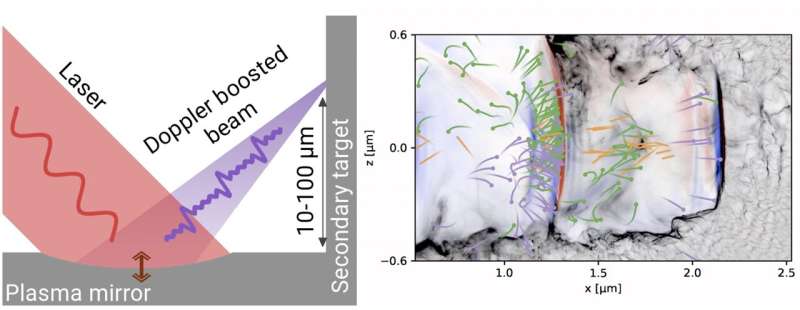
A newly published theoretical and computer modeling study suggests that the world's most powerful lasers might finally crack the elusive physics behind some of the most extreme phenomena in the universe—gamma ray bursts, pulsar magnetospheres, and more.
The international research team behind the study includes researchers from Lawrence Berkeley National Laboratory (Berkeley Lab) and France's Alternative Energies and Atomic Energy Commission (CEA-LIDYL). They report their findings in the prestigious journal Physical Review Letters.
The research team was led by CEA's Henri Vincenti, who proposed the main physical concept. Jean-Luc Vay and Andrew Myers, of Berkeley Lab's Accelerator Technology and Applied Physics (ATAP) Division and Computational Research Division, respectively, led development of the simulation code used for the research. (Vincenti previously worked at Berkeley Lab as a Marie Curie Research Fellow and remains an ATAP affiliate and frequent collaborator.) The theoretical and numerical work was led by Luca Fedeli from Vincenti's team at CEA.
The team's modeling study shows that petawatt (PW)-class lasers—juiced to even higher intensities via light-matter interactions—might provide a key to unlock the mysteries of the strong-field (SF) regime of quantum electrodynamics (QED). A petawatt is 1 times ten to the fifteenth power (that is, followed by 15 zeroes), or a quadrillion watts. The output of today's most powerful lasers is measured in petawatts.
"This is a powerful demonstration of how advanced simulation of complex systems can enable new paths for discovery science by integrating multiple physics processes—in this case, the laser interaction with a target and subsequent production of particles in a second target," said ATAP Division Director Cameron Geddes.
Lasers probe some of nature's most jealously guarded secrets
While QED is a cornerstone of modern physics that has withstood the rigor of experiment over many decades, probing SF-QED requires electromagnetic fields of an intensity many orders of magnitude beyond those normally available on Earth.
Researchers have tried side routes to SF-QED, such as using powerful particle beams from accelerators to observe particle interactions with the strong fields that are naturally present in some aligned crystals.
For a more direct approach, the highest electromagnetic fields available in a laboratory are delivered by PW-class lasers. A 10-PW laser (the world's most powerful at this time), focused down to a few microns, can reach intensities close to 1023 watts per square centimeter. The associated electric field values can be as high as 1014 volts per meter. Yet studying SF-QED requires even higher field amplitudes than that—orders of magnitude beyond what can be achieved with those lasers.
To break this barrier, researchers have planned to call on powerful electron beams, accessible at large accelerator or laser facilities. When a high-power laser pulse collides with a relativistic electron beam, the laser field amplitude seen by electrons in their rest frame can be increased by orders of magnitude, giving access to new SF-QED regimes.
Though such methods are challenging experimentally, as they call for the synchronization in space and time of a high-power laser pulse and a relativistic electron beam at femtosecond and micron scales, a few such experiments have been successfully conducted, and several more are planned around the world at PW-class laser facilities.

Using a moving, curved plasma mirror for a direct look
The research team proposed a complementary method: a compact scheme that can directly boost the intensity of existing high-power laser beams. It is based on a well-known concept of light intensification and on their theoretical and computer modeling studies.
The scheme consists of boosting the intensity of a PW laser pulse with a relativistic plasma mirror. Such a mirror can be formed when an ultrahigh intensity laser beam hits an optically polished solid target. Due to the high laser amplitude, the solid target is fully ionized, forming a dense plasma that reflects the incident light. At the same time the reflecting surface is actually moved by the intense laser field. As a result of that motion, part of the reflected laser pulse is temporally compressed and converted to a shorter wavelength by the Doppler effect.
Radiation pressure from the laser gives this plasma mirror a natural curvature. This focuses the Doppler-boosted beam to much smaller spots, which can lead to extreme intensity gains—more than three orders of magnitude—where the Doppler-boosted laser beam is focused. The simulations indicate that a secondary target at this focus would give clear SF-QED signatures in actual experiments.
Berkeley Lab integral to international team-science effort
The study drew upon Berkeley Lab's diverse scientific resources, including its WarpX simulation code, which was developed for modeling advanced particle accelerators under the auspices of the U.S. Department of Energy's Exascale Computing Project. The novel capabilities of WarpX allowed the modeling of the intensity boost and the interaction of the boosted pulse with the target. All previous simulation studies had only been able to explore proof-of-principle configurations.
Experimental verification of the research team's methodology for probing SF-QED might come from the Berkeley Lab Laser Accelerator (BELLA), a petawatt-class laser with a repetition rate, unprecedented at that power, of a pulse per second. Now under construction is a second beamline that might also contribute to experimental studies of SF-QED by Berkeley Lab researchers. A proposed new laser, kBELLA, could enable future high rate studies by bringing high intensity at a kilohertz repetition rate to the facility.
The discovery via WarpX of novel high-intensity laser-plasma interaction regimes could have benefits far beyond ideas for exploring SF-QED. These include the better understanding and design of plasma-based accelerators such as those being developed at BELLA. More compact and less expensive than conventional accelerators of similar energy, they could eventually be game-changers in applications that range from extending the reach of high-energy physics and of penetrating photon sources for precision imaging, to implanting ions in semiconductors, treating cancer, developing new pharmaceuticals, and more.
"It is gratifying to be able to contribute to the validation of new, potentially very impactful ideas via the use of our novel algorithms and codes," Vay said of the Berkeley Lab team's contributions to the study. "This is part of the beauty of collaborative team science."
Citation: Cracking open strong field quantum electrodynamics (2021, September 28) retrieved 28 September 2021 from https://ift.tt/3F09gwQ
This document is subject to copyright. Apart from any fair dealing for the purpose of private study or research, no part may be reproduced without the written permission. The content is provided for information purposes only.
It’s called a circumtriple planet, and evidence that one exists suggests that planet formation is less unusual than once believed.
GW Ori is a star system 1,300 light years from Earth in the constellation of Orion. It is surrounded by a huge disk of dust and gas, a common feature of young star systems that are forming planets. But fascinatingly, it is a system with not one star, but three.
As if that were not intriguing enough, GW Ori’s disk is split in two, almost like Saturn’s rings if they had a massive gap in between. And to make it even more bizarre, the outer ring is tilted at about 38 degrees.
Scientists have been trying to explain what is going on there. Some hypothesized that the gap in the disk could be the result of one or more planets forming in the system. If so, this would be the first known planet that orbits three stars at once, also known as a circumtriple planet.
Now the GW Ori system has been modeled in greater detail, and researchers say a planet — a gassy world as massive as Jupiter — is the best explanation for the gap in the dust cloud. Although the planet itself cannot be seen, astronomers may be witnessing it carve out its orbit in its first million years of its existence.
A paper on the finding was published in September in the Monthly Notices of the Royal Astronomical Society. The scientists say it disproves an alternative explanation — that the gravitational torque of the stars cleared the space in the disk. Their paper suggests there is not enough turbulence in the disk, known as its viscosity, for this explanation to suffice.
The finding also highlights how much more there is to learn about the unexpected ways in which planets can form.

Anyone who has watched George Lucas’ original “Star Wars” is familiar with planets that can have two stars rising and falling in its skies. Luke Skywalker’s dusty home of Tatooine was in such a binary star system. But a planet orbiting three stars would be more unusual.
If a familiar life form could dwell on a gas giant like the one that would be orbiting GW Ori, it would not actually be able to see the three stars in its skies. Rather, they would see only a pair as the two innermost stars orbit so close as to appear like a single point of light. Yet as the planet rotated, its stars would rise and fall in fascinating sunrises and sunsets unlike any other known world.
“‘Star Wars’ missed a trick,” said Rebecca Nealon from the University of Warwick in England, a co-author on the paper.
Scientists have been on the lookout for a planet orbiting three stars, and found potential evidence in another system, GG Tau A, located about 450 light years from Earth. But the researchers say the gap in GW Ori’s gas and dust ring makes it a more convincing example.
“It may be the first evidence of a circumtriple planet carving a gap in real time,” said Jeremy Smallwood from the University of Nevada, Las Vegas, lead author of the new paper.
William Welsh, an astronomer at San Diego State University, said the researchers “make a good case. If this turns out to be a planet, it would be fascinating.”
Alison Young from the University of Leicester in England who has argued that GW Ori’s stars caused the gap in the system’s disk, rather than a planet, notes that observations from the ALMA telescope and Very Large Telescope in Chile in the coming months could end the debate.
“We’ll be able to look for direct evidence of a planet in the disk,” Dr. Young said.
If the planet hypothesis is confirmed, the system would reinforce the idea that planet formation is common. Several worlds, known as circumbinary planets, are already known to orbit two stars at once. But circumtriple planets have been harder to come by — despite estimates that at least a tenth of all stars cluster in systems of three or more. Yet their possible existence suggests that planets spring up in all sorts of places, even here in this most bizarre of systems.
“Three stars is not enough to kill planet formation,” Dr. Nealon said.
That suggests that exoplanets are likely to arise in more and more unusual locations. “What we’ve learned is any time planets can form, they do,” said Sean Raymond, an astronomer from the University of Bordeaux in France who was not involved in the paper.
Perhaps even a world orbiting four, or five, or six stars at once?
“I don’t see why not,” he said.
The Northern lights were visible from the Bogus Basin ski resort in Boise, Idaho. Photo: Kyle Green (AP) On Friday, Earth was hit ...
